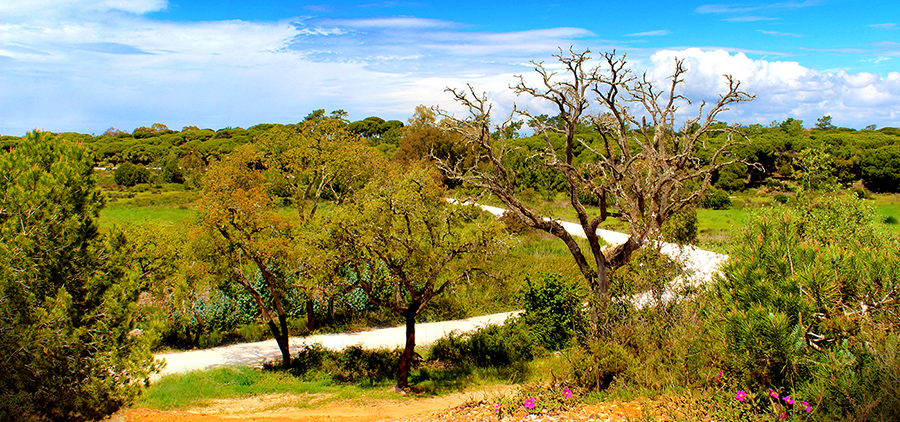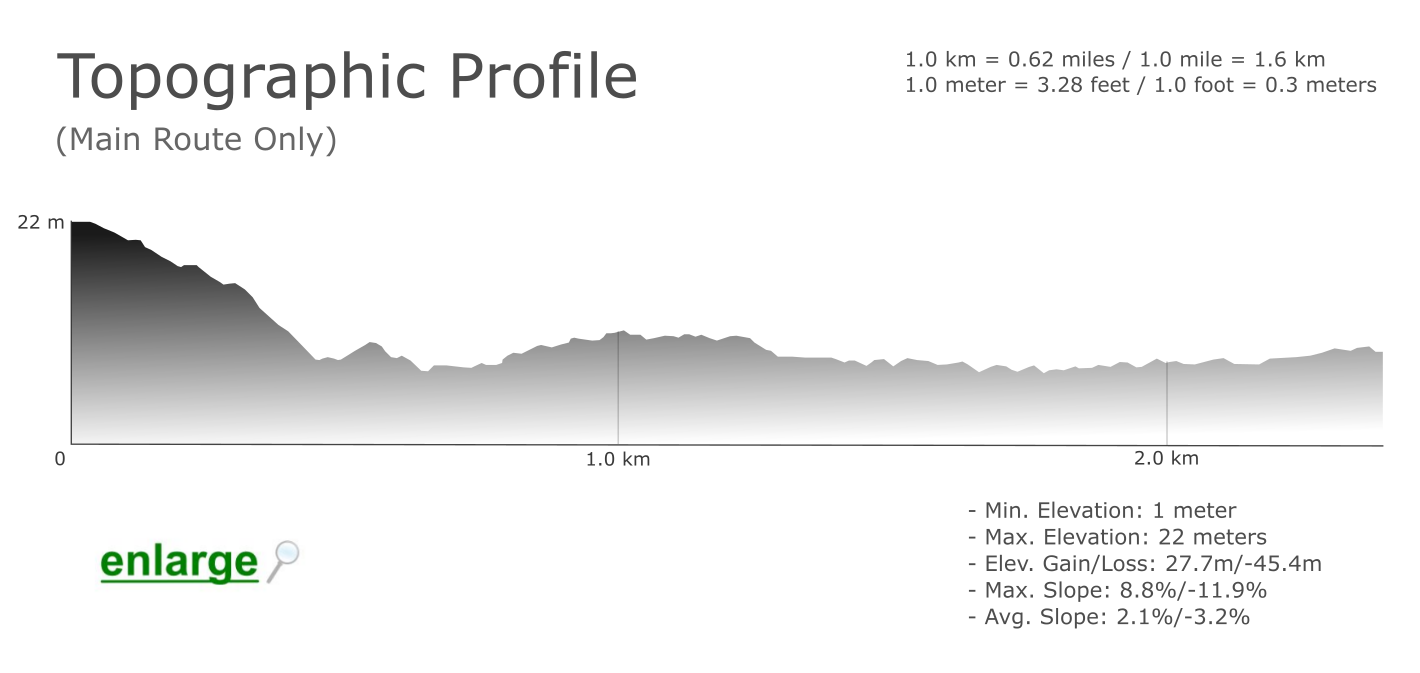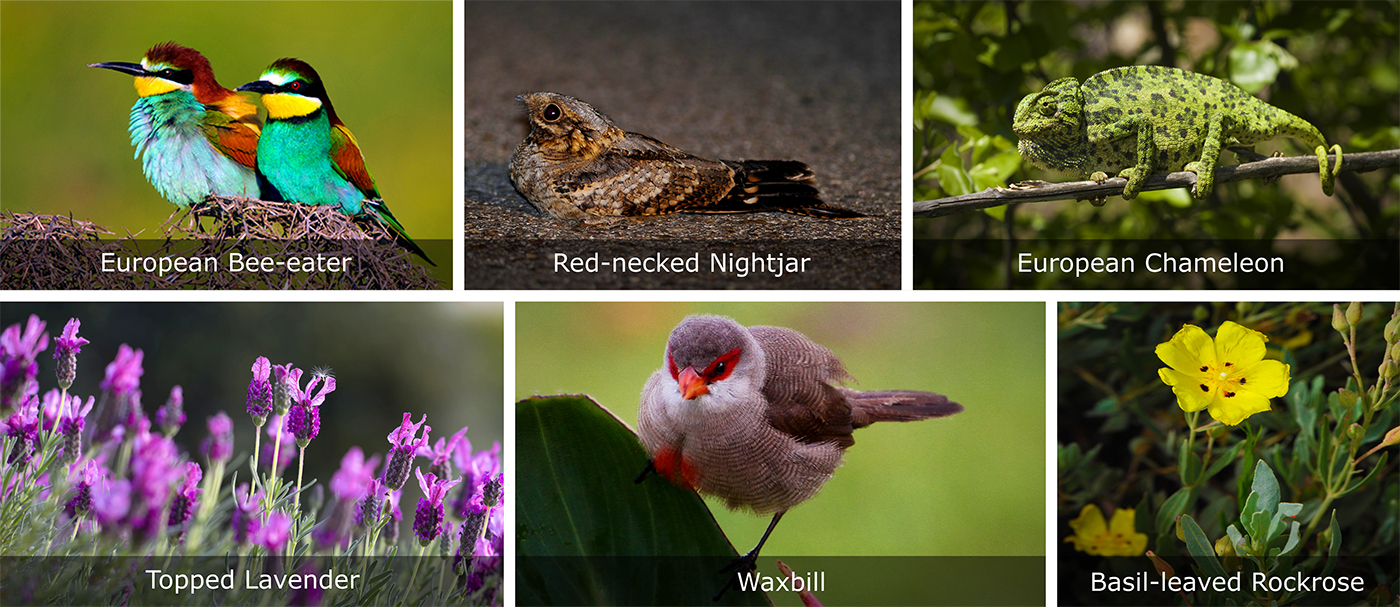
TRAIL FACTSHEET: PONTAL FOREST TRAIL | RIA FORMOSA
PONTAL FOREST TRAIL | BIRDS & NATURE: PLEASE SEE HERE
Location: Mata do Pontal, Rua Henriques Fernando Serrão, Faro; Faro Municipality, Central Algarve | Coordinates: 37.030619 N, -7.976154 W (decimal degrees) | Grade: Easy; Secondary Loop Trail can be difficult | Type: Linear Trail (Out & Back) – it merges with the Ludo Trail; Pontal’s Secondary Trail is a Loop Trail; | Length: 2400 meters (1.5 miles); Secondary Trail runs for 1600 meters (1.0 mile) | Average Completion Time: up to 1-2 hours | Best Time to Visit: all year-round; especially good in late spring for botanical species; late summer is the worst time to observe plants | Best Time for Birdwatching: spring, autumn and winter; all seasons offer good birding opportunities | Activities: birding; nature walks; cycling, running & other outdoor activities; sightseeing.
The largest forest in Faro, Pontal encloses rich habitats that include reed beds, meadows, and the highly threatened Mediterranean temporary ponds. At first sight apparently not relevant, those ponds are actually of the utmost importance for a lot of plants and animals living under Mediterranean-type climates. That’s why they are considered a ‘priority habitat’ by national and international organizations. When visiting in late winter or early spring, you’ll probably spot red dragonflies hunting above their shallow waters, as well as thirsty birds drinking along their ephemeral margins.
Here, particularly abundant bird species include Iberian Azure-winged Magpie, Collared Dove, Hoopoe and Jay. The Red-necked Nightjar (a nocturnal bird), and the Iberian Green Woodpecker are also plentiful but their cautious habits make them a bit more challenging to watch out in the open. Pontal also shelters populations of Wryneck, Crested Tit, Short-toed Treecreeper, Wood Pigeon, Crested Lark and Stonechat, as well as a variety of warblers. But the forest’s crowning moment arrives in spring, when the gorgeous Bee-eater starts to glide well above the tree tops.
The beginning of the warm season also heralds the arrival of colour on the sandy soils of Pontal: everywhere, you’ll see purple Lavender, white flowers of Thyme, and vivid yellow carpets of Daisies mixed with Basil-leaved Rock Roses. The fairly small Mediterranean climate regions are home to a staggering one-fifth of the world’s plant species, and the Pontal Forest really underscores this circumstance. During spring, the quantity and variety of plant species found throughout its clearings can be mind-boggling.
In fact, the Pontal Forest is also one of the very few places in the world where you can see both the beautiful inflorescence of the Big-Headed Thyme (Thymus lotocephalus) and the fragile Great Spotted Rock Rose (Tuberaria major). With their very limited and fragmented distribution area, both these Algarvian plants are extremely endangered; in reality, the Great Spotted Rock Rose is facing complete extinction – and that’s why protecting the Pontal Forest from unrestrained touristic development is so crucial. Due to economic incentives, by visiting and appreciating the leafy woods you’re also helping staving off this threat.
 The dirt trail starts near Faro Airport on an unpaved road that leads to Quinta do Ludo. On the left-hand side you’ll see a large patch of Umbrella Pines that provides good chances to observe some of the resident birds, as well as the always elusive Chameleons (provided you are eagle-eyed). A bit further down the trail there is a sort of oasis with rows of Palm Trees growing together. This place is home to several passerine species like the Serin, the Waxbill, and the Greenfinch. You’ll probably see Pallid Swifts cruising the atmosphere slightly above the trees, as well as the odd Black Kite or White Stork silhouetted against the blue sky. Here, opposite to a ruined farm building, a few Cork Oaks mark the access to a secondary trail which runs first along the Palm Trees, turning then deeper into the forest towards a clearing (please check map). You can explore this smaller trail to observe the birds up close but bear in mind that this route is not signposted. This side route can also be rough, and it can become slippery when it rains.
The dirt trail starts near Faro Airport on an unpaved road that leads to Quinta do Ludo. On the left-hand side you’ll see a large patch of Umbrella Pines that provides good chances to observe some of the resident birds, as well as the always elusive Chameleons (provided you are eagle-eyed). A bit further down the trail there is a sort of oasis with rows of Palm Trees growing together. This place is home to several passerine species like the Serin, the Waxbill, and the Greenfinch. You’ll probably see Pallid Swifts cruising the atmosphere slightly above the trees, as well as the odd Black Kite or White Stork silhouetted against the blue sky. Here, opposite to a ruined farm building, a few Cork Oaks mark the access to a secondary trail which runs first along the Palm Trees, turning then deeper into the forest towards a clearing (please check map). You can explore this smaller trail to observe the birds up close but bear in mind that this route is not signposted. This side route can also be rough, and it can become slippery when it rains.
Intersecting the main trail on both sides, next there is a seasonally flooded area where sometimes Sheep or Horses are quietly grazing. This is a good place to find Cetti’s and Sardinian Warblers, as well as Goldfinch. Then, the trail starts to meander across an area covered by Pine trees and large Eucalyptus; more adventurous visitors can follow one of the rough tracks ascending to their right-hand side in order to find a sandy clearing in the middle of the forest. This is the same clearing mentioned above, and the one which can also be reached through the secondary trail that begins next to the Palm Trees. The clearing is where the Bee-eaters are most often found. However, it is necessary to remain silent so as not to scare the birds. This space is also frequented by wild Rabbits, by Genets, and by flocks of Red-legged Partridges. You’ll reach a nice viewing point over the landscape extending to the west at the curve where the side trail starts to inflect towards the main trail. But always keep a safe distance from the steep slopes’ and cliffs’ edges at all times.
You’ll see a large area strewn with thick reeds, rush, reedmace, and sedge further down the main trail; acting as a crucial ecological corridor, this wetland is frequented by Great Reed Warblers, White Storks, Cormorants and Zitting Cisticolas, as well as by Melodious Warblers during their migration. The Western Marsh Harrier and the Purple Heron are occasional inhabitants. A series of narrow aquatic channels on the right are also frequented by several species of ducks, like the Red-crested Pochard, the Mallard, the Tufted Duck, and the Northern Shoveler. On the left, there are shallow saltpans where the Greater Flamingo, the Avocet, and the Black-winged Stilt are common sights. The Pontal Trail finally merges with the Ludo Trail just after the bridge crossing Ribeira de São Lourenço. During the colder months, this bridge offers excellent views over the large gatherings of coots, ducks, and moorhens wintering at this rich corner of the Ria Formosa Natural Park. Enjoy!
